By TERRENCE RAFFERTY
Photographed by Steve Pyke
Ron Howard has been in the business for better than half a century, and he’s only 55. He acted in his first movie, The Journey, when he was 4. He directed his first film, Grand Theft Auto (1977), at 23; and his accomplishments in his three decades behind the camera have long since eclipsed those of the 20-plus years he had previously labored in front of it.
His most recent movie, Angels & Demons, is the 20th he’s directed. He has won two DGA Awards, for A Beautiful Mind (2001) and Apollo 13 (1995), and been nominated two more times for Frost/Nixon (2008) and Cocoon (1985). A Beautiful Mind and Frost/Nixon also were nominated for best picture and best director Oscars; A Beautiful Mind won both.
Howard is also a partner in one of Hollywood’s most successful film and television production companies, Imagine Entertainment, which he founded with Brian Grazer in 1986.
On a sweltering August day in New York, Howard looked every inch the confident industry professional, wearing a dark suit and a white dress shirt (no tie) and posing uncomplainingly for a photographer on the sun-baked balcony of the DGA’s midtown offices. Something seemed to be bothering him a little, though. It was the coffee mug—an attractive ceramic item embossed with the logo of the Directors Guild of America. After a couple of sips, he mused aloud: “I’ve won two DGA Awards. Shouldn’t I get one of these?”
He has the reputation of being a heck of a nice guy, and that reputation is, I learned, fully deserved. He’s good-humored, unpretentious, and scrupulously polite. But he’s also a wily veteran. After 50-plus years in a rugged business, he knows what’s due him, and how to get it. When our conversation was over, he took his cup home.
Terrence Rafferty: I often ask filmmakers if they remember when they first became aware that there was such a thing as a director, but in your case that seems kind of silly. You must have known pretty much all your life.
Ron Howard: It just seeped into my consciousness, I guess. But as a kid, even though I had been directed and I understood that there was someone called the director whom I’d interacted with, I don’t think I really understood it until I saw my father, Rance, directing a small Equity-waiver theater production in Los Angeles. I really saw him working with actors and shaping the scenes, and I began to put it together on a deeper level. Up till then, the director was just a person who told me where to stand.
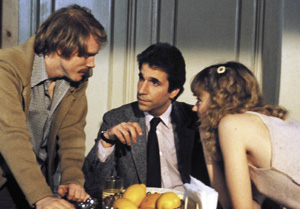 IN PRODUCTION: The young Ron Howard with Henry Winkler
IN PRODUCTION: The young Ron Howard with Henry Winkler
and Shelley Long on Night Shift.
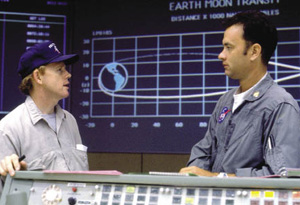 With Tom Hanks in the control room of Apollo 13.
With Tom Hanks in the control room of Apollo 13.
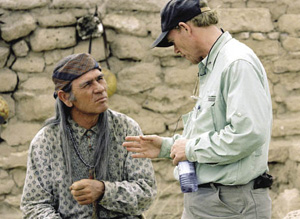 Making the Western The Missing with Tommy Lee Jones.
Making the Western The Missing with Tommy Lee Jones.
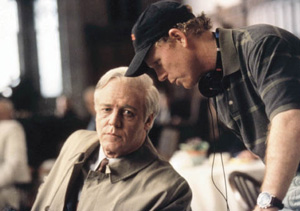 Directing Russell Crowe as the schizophrenic John Nash in A Beautiful Mind.
Directing Russell Crowe as the schizophrenic John Nash in A Beautiful Mind.
(Credits:(top to bottom) Warner Bros./Photofest; Universal; Columbia/Everett; Universal/Everett)
Q: Were you already working on The Andy Griffith Show then?
A: I think so. At some point in the course of that show, I remember noticing that the director was the person who was interacting with everybody, and that looked interesting to me, because I liked what everybody did. I’d be sitting on the dolly, learning to turn the wheels and look through the viewfinder, or I’d be up talking to the sound guys learning how to guide the boom around the set.
Q: It was like a big playpen for you.
A: It was. I loved being a cast member, and I was allowed to be a cast member like everybody else. We had great directors who had all been actors. A guy named Bob Sweeney directed most of the first three seasons, and Sheldon Leonard, who was the executive producer, directed a bit, too. The episodes were like little movies. It was a single-camera show, so the directors were vitally important. The writers were around for the read-throughs on Thursdays, but the director really took over for the rehearsals on Fridays, and then we’d film on Monday, Tuesday, and Wednesday. It was a tremendous environment because although there was a lot of laughter, there was also a real keen sense of purpose.
Q: Did you ever get bored with the grind of making a weekly series?
A: Even though it was a quick schedule, it never felt like factory work. Later I’d sometimes do guest shots on other TV shows and it felt really different, like an assembly line. On The Andy Griffith Show, you never got the feeling anyone was phoning it in, because Andy didn’t, ever. It wasn’t until I was in film school that I realized that those episodes were artfully made, and thoughtfully made. You’d have been tarred and feathered and run off the lot if you’d ever mentioned a metaphor, or anything like aesthetic principles, but they were there—a very singular tone and point of view.
Q: Not too long after that, you wound up in another popular, long-running sitcom.
A: I’m grateful for the broad, energized, heightened comedy experience I had working on Happy Days, which began as a single-camera show and became a multi-camera show. It gave me a chance to work in front of an audience and really feel and understand comedy timing and tone, how to reach past the ordinary for the big, hard laughs.
Q: You hadn’t had much stage experience.
A: None. Scared the crap out of me when I first began doing it. And again, there was a great DGA member in charge, Jerry Paris—he signed my card when I joined. He directed maybe 90 percent of the episodes, and he was kind of a genius at staging and energizing a scene through blocking. At the time, he and Jay Sandrich were the stars of the multi-camera directors.
Q: Now that you’re on the other side of the camera...
A: The thing I always try to do when I direct children or young actors is to teach good fundamentals. I don’t direct just to get a result, I don’t want to treat kid actors like they’re props or trained animals that I’m trying to get a look or a sound out of. When my dad was teaching me my lines, he was always giving me basic Actors Studio stuff, like listening to the actors, looking into their eyes and really hearing what they were saying. He wanted me to understand how to make the scenes real interactions, real conversations.
Q: By the time you were a teenager, movies and TV were really starting to change.
A: My early adolescence coincided with this amazing era in movies. The Graduate and Bonnie and Clyde, in ’67, were addressing a lot of things that I and others in my generation were beginning to feel. I started to see that there was this other level that was beyond what we were doing in television, which, from a photographic standpoint, had such strict rules and boundaries—sort of a fundamentalism. And I fell in love with the medium and began to read about directors. I started to see that the job of the director could be more personal and complex.
Q: Even though you’d been on sets all your life, you were discovering movies the same way everyone else of your generation was.
A: That’s right, weirdly enough. To a degree I could apply my professional experience, but what a trip it was when I acted in American Graffiti, which was nothing like anything I’d ever been around.
Q: You’d worked in the old Hollywood culture.
A: Yes, very traditional. Apart from one complicated crane shot I remember Vincente Minnelli staging in The Courtship of Eddie’s Father, and some sort of Busby Berkeley elements in The Music Man, the movies I’d made didn’t seem to me all that different from being on The Andy Griffith Show. The master, then the close-ups, then the scene was over. So it was thrilling to be exposed to this whole other approach in American Graffiti.
Q: After that, you went to film school for a while. Did you learn a lot at USC?
A: I did, largely because this was the beginning of the era of independent filmmakers, and although I wound up being somebody working in the system, I was influenced by that, and USC emboldened me to feel that I could go make an independent movie of my own. Which I started to do—a Cassavetes-style movie, improvisationally based—but I didn’t finish because I went to work for Roger Corman instead.
Q: And Corman gave you the chance to direct your first movie, Grand Theft Auto, when you were 23.
A: The first day of shooting was the day after my 23rd birthday. I will admit that I was behind in my personal schedule, I was running late. I really wanted to direct a film in my teens. Hubris of youth. I was very anxious that first day. I read an article a few years ago in which Corman said I was one of the coolest, calmest first-day directors he’d ever seen. But I was really jumpy, and the first half of that first day didn’t go very well; I only got about four or five setups. Gary Graver, the cinematographer, sat down with me at lunch and we figured out how to avoid some problems and simplify a few things. He saved my ass. I literally thought I might get fired at lunch.
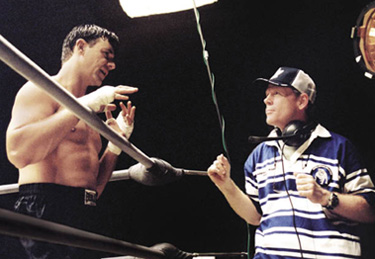 KNOCK OUT: In Cinderella Man, Howard found a way to visually show
KNOCK OUT: In Cinderella Man, Howard found a way to visually show
what was goingon psychologically for boxer Jim Braddock
(Russell Crowe). (Photo: Universal/Everett Collection)
Q: How many setups were you supposed to get per day?
A: Twenty was the minimum.
Q: And what was the shooting schedule?
A: Twenty-two days.
Q: The numbers are burned into your brain.
A: Oh, absolutely. Corman said, ‘I’m going to come visit the first couple of days, and if things are going well, you won’t see much of me after that. If they’re not, you’ll see a hell of a lot of me.’ By the third day, I was flying through the schedule, and I felt confident. But about two-thirds of the way through, I was struggling to get more extras for the climactic demolition derby scene. Roger kept saying no, no, no, and I was really annoyed. Then he put his hand on my shoulder in a kind of paternal way and said, ‘Ron, if you do a good job for me on this movie, with all the restrictions and limitations, you’ll never have to work for me again. And I haven’t. But the education was fantastic, the work felt wonderful, and the wrap party was a highlight of my life.
Q: What was your first experience with post-production like?
A: The first cut was mortifying. I always warn people who are making their first movie to brace themselves. You just have to face it.
Q: What was so awful?
A: I realized I hadn’t really learned to be collaborative, to benefit from that loose but disciplined spirit we had on The Andy Griffith Show. I’ve since learned how to do that in a manageable, controlled way as a director.
Q: What were you doing instead?
A: Because I was an actor, I was playing every role in my mind and trying to make puppets out of everybody. And because I was young, I was terrified that people would second-guess me. I was so prepared, and pretty dictatorial about how things had to go. It took me awhile to figure out that people weren’t going to try to undermine me, that it’s in everybody’s interest for the director to succeed.
Q: Dictatorial? It’s hard to imagine you as Otto Preminger.
A: [Laughs] The ginger-haired version. It’s my job as the director to be tough enough, clear enough and knowledgeable enough about what the story needs that I can make quick judgments as to whether or not something in fact realizes the full potential of the moment. I go to work every day with a foundation, my version, and I used to really fight to enforce that, because I was afraid if I didn’t, it would get away from me. But using collaboration as a jumping-off place is much more exciting; the day’s work can go places I hadn’t necessarily imagined it might, and that’s where the exhilaration lies.
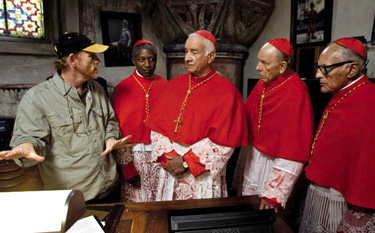 LOSING HIS RELIGION: Howard, with the cardinals in Angels & Demons,
LOSING HIS RELIGION: Howard, with the cardinals in Angels & Demons,
had to shoot some scenes quickly because he had the location only for a
limited time. (Photo Credits: Zade Rosenthal/Columbia Pictures)
Q: When did you come to that realization?
A: I was a little disappointed in my first movie, and the first couple of TV movies I made after
that. I just felt like the magic wasn’t happening, you know? But by the time I was doing Night Shift [1982], which was my first high-profile film but maybe my fifth or sixth undertaking as a director, I was much looser and freer. I was able to let Michael Keaton run with that wild character, and to trust him. He and Henry Winkler both had the green light to ad-lib, but we also had a fantastic script by Lowell Ganz and Babaloo Mandel.
Q: Who also wrote your next film, Splash [1984], which was a hit. But after that you started turning away from comedy a bit.
A: Well, I felt like I’d been typed as an actor, and I didn’t want to be typed as a director. I love comedy. In fact, I sort of miss it. When I look at what I’ve done in the last 10 years, I think the only thing missing is the big, character-driven comedy.
Q: Unless you count Frost/Nixon.
A: I was just about to say that. I loved making that movie, every second of it. The writing was fantastic, but there was also some improv, which was liberating for the actors. I encouraged a lot of spontaneity with the secondary characters, just to work in opposition to the formality of the piece as a play. And because Frank Langella and Michael Sheen had lived with the play for so long, I wanted to create some throwaway stuff around that brilliant writing by Peter Morgan at the center, to give it a feeling of immediacy. For budgetary reasons, we needed to make it quickly. We never had to compromise, but we needed to bring our A game every day and be conscious of not letting things slip away, not getting lazy or sloppy about anything.
Q: What was the schedule?
A: It was 40 days, but we did it in 38. The actors were so well prepared, and Sal Totino, the cinematographer, was going like a bat out of hell all the time. We’d chosen a style that lent itself to moving quickly, that generated a lot of momentum.
Q: Did that make it more of a challenge for the editors?
A: The way I shoot, it’s always a challenge for the editors. Dan Henley and Mike Hill, whom I’ve worked with since Night Shift, are really remarkable. They cut for performance first and foremost, and they work from the heart—I don’t mean sentimentality, but emotion. I always go back and comb through dailies to make sure that we’ve not let any nuances fall through the cracks unnecessarily, and Mike and Dan have an incredibly high batting average in finding the right take.
Q: Do you enjoy the editing now more than you did on Grand Theft Auto?
A: In a way, editing is the most intimate experience you have on a film. The editing room is like a bunker sometimes, and you’re dug in there for months trying to determine what the film is really going to be. There’s that process of coming to terms with what you have to work with—reconciling what you’d imagined the movie could be with what it actually can be. Sometimes that’s disappointing. But sometimes it’s incredible; sometimes you feel like you’ve discovered the pot of gold at the end of the rainbow.
Q: Is there a film you’ve made that changed drastically in the editing?
A: The first cut of Apollo 13 terrified me. The assembly was four hours and fifteen minutes long. I remember being pretty discouraged when we took a break after two hours and the launch hadn’t happened yet. I stood at the urinal thinking, I’m fucked. [laughs] But as we kept trimming, we could see it come to life. It wasn’t like we were reinventing it, though there were a few short scenes that were entirely manufactured in post.
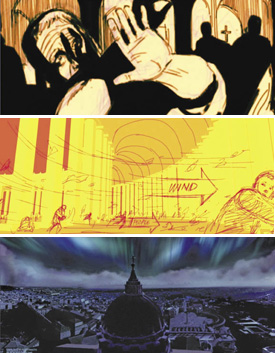 BIG BANG: Howard used storyboards for some of the big action scenes
BIG BANG: Howard used storyboards for some of the big action scenes
in Angels & Demons, like this explosion in St. Peter’s Square.
(Storyboards: Courtesy of Imagine Entertainment)
Q: Like what?
A: Mostly expositional stuff, things about the spacecraft we hadn’t been quite clear enough about that the audience really needed to know. To put people on the edge of their seats they have to fully understand what’s going on. So we’d start on Ed Harris and he’d say something, and we’d cut to a monitor and have a wild line, then cut to something else and steal a line from another scene, a reaction shot, and suddenly we’d fabricated a 35- or 40-second scene that wasn’t in the script and that made the audience feel what they were supposed to feel. That kind of thing is a lot of fun.
Q: Do you storyboard?
A: For very complicated scenes where there are a lot of elements, a storyboard makes it much easier to have a production meeting with the second unit and the art department and the visual effects people and the physical effects people and the actors themselves, if you can point to a frame and say, ‘We need to achieve this.’ I don’t really need a storyboard much, because it all kind of exists in my mind. Once in a while, though, a storyboard artist will give you a visual or an approach to a moment that’s so imaginative that it’s really a gift. That happens more now than it used to. I used to make my shot list and hand it to a storyboard artist along with the script, and then I realized that in the same way I’d been too controlling early on with the actors and cinematographer, I was doing that with the storyboard artists, too, and that I might do better to just have a brief conversation to establish the tone I want and then see what their interpretation is. George Lucas was the guy who tipped me off to that. But I never storyboard a scene unless I think it’s going to benefit from that sort of analysis.
Q: You must need it on elaborate action pictures like The Da Vinci Code and Angels & Demons, though.
A: Actually, it was very helpful when we were shooting the action scenes in Rome for Angels & Demons. We were really under the gun, not because of money, but because we were only allow-ed access to certain locations for a very limited period of time. I’d made the decision to begin storyboarding straight from the novel, even before the screenplay was finished, while we were still shooting Frost/Nixon. I’m glad I did that, and I’m very pleased with some of the action scenes in Angels & Demons: the church scene with the fire, and the scene where Hanks has to go into the water and rescue the cardinal, and our two big scenes in St. Peter’s Square. It was good to have those boards, and to have had a lot of time to live with them. I give a lot of credit to the 2nd unit director, too, Todd Hallowell.
Q: Was Angels & Demons your most difficult movie logistically?
A: From a purely logistical standpoint, I came away from Willow [1988] feeling like I never needed to be frightened again making a movie. I get anxious, I get excited, I have concerns, but I’ve never been afraid since then.
Q: What was so daunting about that film?
A: The effects, and a very demanding set of locations. We had up to three production units going, with which I was constantly interacting: Joe Johnston directed one unit, Micky Moore another. There were so many effects shots, so many physical effects, large-scale staging situations with horses and battles and stunts, and a long, long shooting schedule. Locations ranging from Wales to New Zealand to soundstage work in London to the redwood forest in Marin. Plus, it was a highly anticipated movie—there was a lot of scrutiny.
Q: Was Willow scarier to you than Backdraft [1991]? Do you wish that you’d been able to do all those fire effects digitally?
A: We tried it, but it never looked right. Digital fire still isn’t quite as effective. We had some in Angels & Demons, and it made the shooting much safer. But on Backdraft we had the advantage that the actors could actually wear the turnout suits and all the firemen’s gear. And we used a product called Zel Gel, which you put on your skin and it prevents burning for about 30 seconds. That made it possible for us to do some really ballsy scenes, with the actors charging into the flames and our cinematographer, Mikael Salomon, right behind them in a fireproof suit. The crew gave me a matte box that I have on the wall of my office now: It’s completely melted. [Laughs]
Q: How do you feel about digital effects generally?
A: It’s all about fully creating a world, an environment. Where digital effects help is in allowing you to open up your frame. When you use a matte painting you can’t move the camera. Now you have more freedom; you can create a complete environment.
Q: Any recent technical developments that especially excite you?
A: Well, 3-D doesn’t interest me that much. I’d use it if it was right for the material. But I’m not really a stylist; for me, making movies is so much about character. I’m interested in having enough command of the medium as a filmmaker to be able to look at a story and know how it can best be realized, and to be able to do it.
Q: You came up as a filmmaker at a time when American movies were changing, and I wonder if you think we might be in another of those times now.
A: Definitely. It can be unsettling. Any time you go through a period when technology and delivery systems and distribution systems broaden and change, when there are generational shifts—all that influences what filmmakers do, the decisions they make, the kinds of projects they can work on. But I sometimes think about this 96-year-old guy, named Charles Rainsbury, who had a tiny speaking part in Cocoon. He’d been an actor and a film crew member when Fort Lee, New Jersey, was the center of the film world. He hadn’t been on a set since 1915, 1916. When I asked him how movies had changed since then, he said, ‘We didn’t have to shut up when they were shooting then; otherwise, it’s the same, hurry up and wait.’ And I find that comforting. As we go through this period of transition and worry about whether people are seeing our movies in multiplexes or on cell phones—or seeing them at all—I’m reminded that the thing I love is this process that hasn’t changed so much: You try to tell a story that’s meaningful, and share it with people. What really gets me out of bed in the morning is this lifestyle that I’ve always been a part of: the creative problem-solving, the collaboration.
Q: So moviemaking still gives you that feeling of excitement and discovery.
A: I’ve been thinking back on the last 10 years, and how it’s been a particularly interesting and eclectic decade for me. Ten years ago, I was working on How the Grinch Stole Christmas [2000], which was fraught with challenges from a design standpoint—some of which we met better than others—and it was a kind of physical comedy I hadn’t really done before. But it was great working with Jim Carrey, and it wound up being the number one movie in its year. And then, you know, A Beautiful Mind, with wonderful actors, and winning all those awards. And The Missing [2003] and Cinderella Man [2005] were projects that were very near and dear to me. I’d always wanted to make a pure Western, and I loved the fact that The Missing dealt with this painful period of transformation on the Western frontier, and also dealt with family, which is something I think I understand.
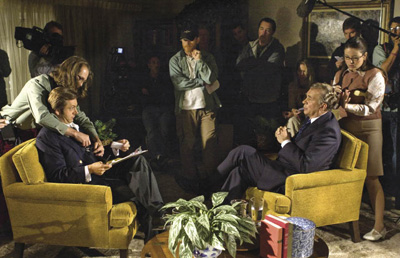 TRICKY DICK: Since Michael Sheen (left) and Frank Langella had done
TRICKY DICK: Since Michael Sheen (left) and Frank Langella had done
their roles so many times on stage, Howard worked to inject some
spontaneity into Frost/Nixon. (Photo: Universal/Everett Collection)
Q: We may be the last generation that believes that you’re not a real American filmmaker until you’ve made a Western.
A: Definitely. My father grew up on a ranch. And I’ve always loved John Ford. But even though the American West was photographed, and the history isn’t so distant, sensibilities have shifted so much that you almost have to adopt another mindset when you’re doing a Western now.
Q: I imagine The Missing was quite a change-up after A Beautiful Mind.
A: Actually, the most unusual thing about Beautiful Mind is that it’s one of the very few films I’ve made that falls into three distinct acts. I’m not generally that concerned with acts; I’m more interested in sequences, the way they initiate and climax and resolve and then lead into other sequences. But John Nash’s story divided itself into acts, into three periods of his life.
Q: And you had to approach each of them differently?
A: Yes. I said to Roger Deakins, the cinematographer, that it seemed to me that John Nash should live in three different kinds of movies, and the first one should be this sort of nostalgic view of America and academia, and that maybe it could look like LIFE Magazine photography. So we have this kind of elegant and somewhat formal beginning to the film. It was very restrained visually, but the colors were rich and the lighting was painterly. And we decided to treat the second part like a Cold War noir spy piece, so we went with a more dynamic range of lenses, and used more powerful camera moves—even a Steadicam 360 shot of Nash at one point.
Q: What did you do stylistically for the last part of the film?
A: We talked about building the tiny house where Nash and his wife lived as a set for convenience, but I really felt that limiting where the camera could be placed would give the right oppressive feeling. You’re not going to be doing an interesting tracking shot, you’re not going to be seduced into bringing a crane in there. I wanted to be boxed in. It wasn’t really documentary style, because we didn’t go to handheld or anything like that. But we didn’t flatter the actors with the lighting, and the camera angles were, for the most, part eye-level.
Q: Do you enjoy mixing up styles within a movie in that way?
A: You know, when I began directing, all my focus was on acting first, writing second. I had to train myself not to just keep recording the actors’ performances, and to use the language of cinema more expressively. But I have to say that it’s still important to me not to impose a style, a personal stamp, on a film. I’d almost prefer that the movies look like they were directed by other people.
Q: What attracted you to Cinderella Man?
A: That was Russell Crowe’s idea, but I’d always wanted to do a film about the Depression. I’d actually made a documentary about it back in high school, which was the first film I made that wasn’t just goofing around. I’m proud of what we did with the boxing, but for me Jim Braddock’s story was mainly an opportunity to put a human face on the urban poor, and especially the working poor. The rural folks kind of understood hardship, but in the cities there were all these people who really felt like they’d had the rug pulled out from under them.
Q: And boxing is always a good vehicle for high drama.
A: I loved working with Sal Totino on that, finding ways to visually express what was going on psychologically for the fighters. That was what I’d liked about his work before I hired him for The Missing: He had these strong, expressive visual ideas that were psychologically driven, that I felt were drawing me into the experience the characters were living through. One of the things I’ve learned along the way is that no matter what the genre is, every story should be a suspense story; You need to think about the conventions of mystery and suspense even if you’re doing a fantasy or a comedy. And another thing I’ve learned is that all stories are really about coping, and what we the audience feel about how the characters are dealing with the challenges they’re facing. Why does a person cope with a situation—a war, or the Depression, or being in outer space—in a certain way? I now try to distill every story to that.
Q: Do you think you could have maintained your level of excitement as an actor?
A: No. Not in my makeup. I look at some of the actors I’ve worked with—Hanks, Carrey, Crowe, Cate Blanchett, Paul Giamatti—people who know how to be artists and help tell the story and collaborate in the process in a way that elevates everything, and do it movie after movie. And I didn’t know how to do that as an actor. I think I was a solid actor, and I wouldn’t mind doing some acting again—maybe I’d be more creative at the job now. But I need to be in the director’s chair, to have that title and that responsibility, in order to be fully creative. That seems to be my personality.
Q: So you’re in the right job?
A: I’m in the right job.